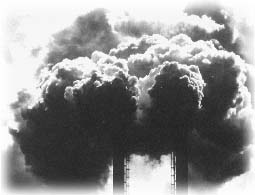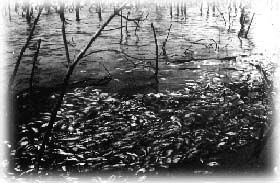|
Environmental
Problems
The
development of science and technology in the twentieth century has greatly raised
the quality of human life but at the same time it has also led to some serious
problems threatening the survival of human beings. Among these are issues concerning
environmental protection. Do you know what the greenhouse effect is? What is acid
rain or the ozone hole? The following passage discusses some of the environmental
problems and the ways to solve them.
Before humans came on the scene,
the world changed only slowly. The climate warmed and cooled, new plants
and animals
and became extinct in their turn, and sea levels rose and fell over periods
of thousands, if not millions, of years. But during the last two thousand years
there have been very great changes. Forests
have disappeared, river courses have been changed, and large areas of natural
vegetation have turned into farmland and cities. There are serious problems
for the survival of the human race.
The greenhouse effect It may be cold outside, but on a sunny day it
can be hot in a greenhouse. Some of the gases in the Earth's atmosphere act
like the glass in a greenhouse. from the Sun can pass through
them to warm the Earth below. But the ground also loses heat by radiation. The
"greenhouse gases" send some of this heat back towards the Earth’s surface and
help to keep it warm. However, by burning fuels and forests, we are putting
larger and larger amounts of these greenhouse gases into the atmosphere. As
a result, the Earth is slowly warming up. This is called the greenhouse effect.
Greenhouse gases is the main greenhouse gas in the atmosphere. Animals
(like ourselves) give out carbon dioxide when they breathe, while plants
breathe in carbon dioxide. In this way, animals and plants keep the atmosphere
in balance and the amount of carbon dioxide stays the same.
However, our modern life-style is destroying the balance. When we burn fuels
in vehicles and power-stations, huge amounts of extra carbon dioxide go into
the atmosphere. In some countries people are burning vast areas of tropical
rainforest and opening land for development or cattle-rearing. This is causing
a double problem. The burning is releasing more carbon dioxide and the Earth
is left with fewer plants to breathe in the gas.
There are several other greenhouse gases in the atmosphere. comes
from animal waste, swamps, rice paddy-fields, and oil and gas rigs.
comes from car exhausts and from chemical fertilizers.
have been used in refrigerators and freezers. Amounts of CFCs in the
atmosphere are small, but these gases are 10 000 times more effective than carbon
dioxide at trapping heat.
Solving the problem The
problem with the greenhouse effect began about 100 years ago when people started
using fuels like oil and petrol on a large scale. On average, world temperatures
have risen by about half a degree (Celsius) over the last 100 years. They could
rise by another three degrees over the next 50 years. This may not sound very
much. But it could cause dry weather in some parts of the world. If the polar
ice-caps melt and sea-levels rise, many areas of the world will be flooded.
Scientists believe that the only way to slow the greenhouse effect is for us
to produce less of the gases which cause it. Governments are already trying
to reduce the use of CFCs. We need to use less fuels like petrol, oil, natural
gas and coal. We can develop heating systems and engines which burn fuel more
efficiently. And we can build houses and offices which waste less heat, and
which need fewer vehicles. We can also use sources of power
that do not burn fuel and release carbon dioxide. Nuclear power is one possibility,
but many people are worried about the dangers of using this. Other alternatives
are wind, water, and geothermal power. 
Air pollution and acid rain Pollution is caused when what we do damages
our surroundings. Factories, power-stations and motor vehicles send waste gases
and soot into the air. The polluted air damages people's lungs. Some petrol
has lead in it. The lead comes out in car exhaust fumes and it can cause brain
damage in children.
The waste gases coming from burning coal, oil and petrol include
and . These gases may dissolve in water in the atmosphere to
form weak acids. They later fall to the Earth as acid rain, sometimes hundreds
of kilometers from where they were formed. Much of the acid rain in Canada is
caused by smoke from factories and power-stations in the USA; the acid rain
in Scandinavia may come from Britain.
Acid rain attacks trees and other plants, and kills the fish and water animals
living in lakes and rivers. Acid rain and polluted air also damage the bricks
and stonework of buildings, and the metalwork of steel bridges and
railings.
Preventing acid rain Acid rain is difficult to control because it spreads
so far. Building tall chimneys reduces the effect near the factory, but passes
the pollution on to other areas. There are some types of coal and oil which
have very little sulphur in them. The waste gases of factories and power-stations
can also be cleaned before they leave the factory, and cars can use devices
to clean their exhaust smoke. These methods are all expensive.
The ozone hole is a gas which forms a layer around the planet
at about 20 to 50 km (6 to 30 miles) above the Earth’s surface. The ozone layer
prevents the Sun's dangerous reaching the Earth where
it would damage our skin and cause cancers. Many scientists are worried that
the ozone layer is being destroyed by the CFCs which are used in refrigerators
and freezers. These chemicals are also important greenhouse gases. At certain
times of the year the ozone layer becomes extremely thin near the north and
south poles. Already skin cancers are increasing in Australia.
Many countries are trying to stop the production of CFCs and to find other
chemicals to do the same thing.
Pollution of rivers, lakes and the sea Air pollution affects rivers
and lakes indirectly because it causes acid rain. But rivers may also be polluted
directly. Some towns and villages send waste material and waste water into rivers,
while factories sometimes release poisonous wastes into the water. Fertilizers
and chemical pesticides used by farmers can also be washed by rainwater into
rivers and streams. They can kill fish and other water animals and plants.
Rivers eventually flow into the sea, carrying their pollution with them. But
the sea can also be polluted directly. Some coastal towns and cities send their
waste water straight into the sea, killing seabirds, shellfish and other wildlife.

All power-stations need huge amounts of water to cool them. This is taken from
rivers, lakes or the sea. When it is returned the water is warmer than it was
originally. Warm water does not hold as much oxygen as cold water, so it harms
animals. It may kill fish and other water animals in the immediate area or prevent
them from breeding.
Radioactive waste Nuclear power-stations produce waste which is radioactive.
Some of this waste is released by the power-stations into the air or water;
some is stored. It can be carried long distances by wind or by water. Many scientists
worry about the long-term effects of this type of pollution on humans and wildlife.
(1 186 words)
TOP |
